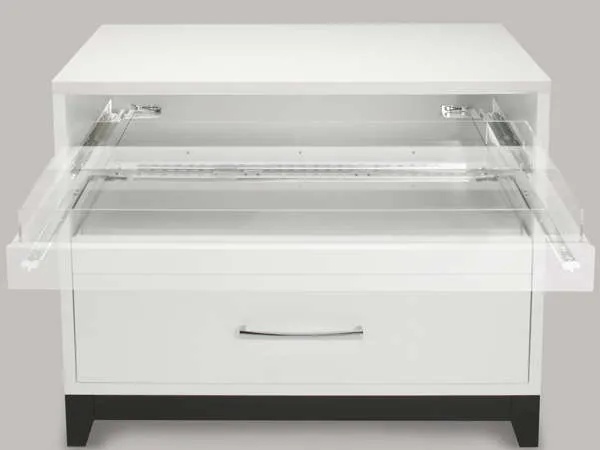What is Drawer Rack and How Do I Fix It?
- Drawer Racking occurs when a drawer’s slides are out of alignment. That misalignment leads the drawer to rack from side-to-side when you try to pull open or push closed a drawer opening.
- The easiest way to prevent drawer racking is to pull open or push closed your slide-based entry evenly, usually at the center of a handle. For wide and tall applications with wide handles or two knobs, use both handles for even push and pull.
- To overcome Racking, pull the drawer out all the way, thus extending the slide members back into alignment. Then push the drawer back in. You may have to do this two or three times to ensure the slide members are fully in sync.
Have you ever had to jerk open a drawer that wouldn’t open smoothly? Odds are you have experienced drawer rack—easily one of the most common problems people have with drawers, storage racks, pull-out shelves and trays, and many other storage fixtures.
What causes drawer rack and how does one prevent or fix it? Let’s find out.
What Causes Drawer Rack

Side-to-side drawer “racking” occurs when moving slide members becomes misaligned.
Racking occurs when a drawer’s slides are out of alignment. Sometimes this happens when you pull open a drawer unevenly. We tend to do this when we hastily pull on a drawer handle or knob from one side. A well-made slide will give you leeway; however, it’ll be just a matter of time before misalignment sets in. That misalignment leads the drawer to rack from side-to-side when you try to pull open or push closed a drawer opening.
The Risk with Wide Drawers and Tall Doors
Racking is especially common on wider drawers, where it’s easy to pull open drawers unevenly just because of the sheer width. The same applies to tall cabinet doors, which can create even more risk since vertical structures are vulnerable to falling.
Overcoming Drawer Rack
The easiest way to prevent drawer racking is to pull open or push closed your slide-based entry evenly, usually at the center of a handle. For wide and tall applications with wide handles or two knobs, use both handles for even push and pull.
In most cases, overcoming drawer rack is easy: Pull a drawer (or whatever slide application you have) out all the way, thus extending the slide members back into alignment. Then push the drawer back in. You may have to do this two or three times to ensure the slide members are fully in sync.

You can find anti-racking cable systems on slides designed for wide or tall drawers. Such heavy-duty applications are especially vulnerable to racking. You can learn more about Accuride’s patented Anti-Rak system by clicking here.
If you find your drawers are still moving disjointedly, then you may have a more serious problem that requires replacement. (Accuride customers can contact a representative on the Accuride Technical Support Page.)
Some more advanced sliding systems, such as the 1332 (for pocket doors) and 3160EC Undermount, use “Anti-Rak” cable-based stabilizers to help reduce the likelihood of misalignment with tall and wide openings. Other systems for wide and tall applications, such as lateral filing cabinets in offices and commercial spaces, often use a rack-and-pinion-type mechanism to prevent racking.
Being aware of the cause of likely issues, such as drawer rack, can go a long way to maintaining your fixtures. Who knows—maybe your well-cared-for slides will outlast the cabinet they’re used in.
Stay connected with Accuride for all your moving design needs! And don’t be afraid to reach out to us to pitch us topics or send feedback! You can find us on social media. Just click your preferred social platform below.
Related Posts
5 Project Plans with Accuride Slides
June 6th, 2023
What is Progressive Movement in a Slide?
June 5th, 2023
Has Your Drawer Slide Lost Its Smooth Movement?
June 5th, 2023
